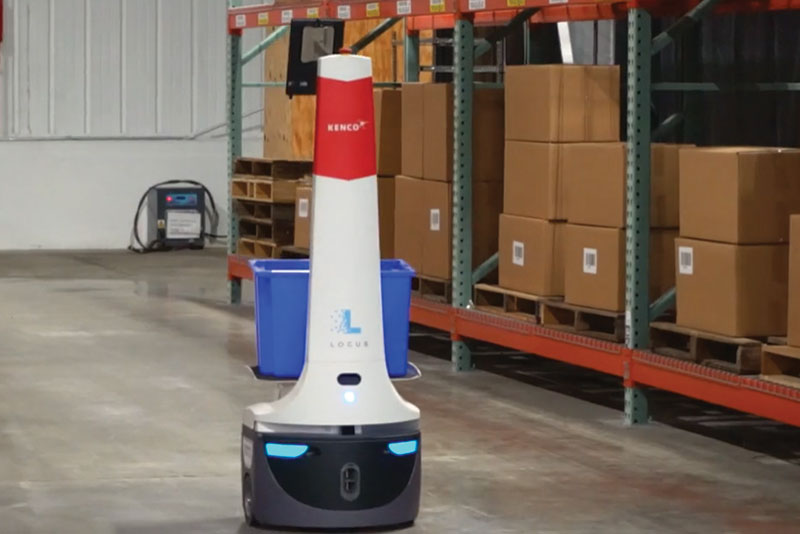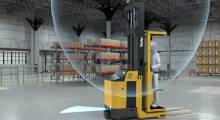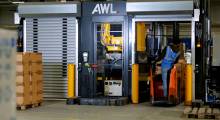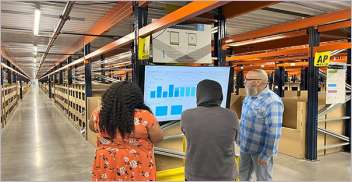It is still early days for widespread use of technologies like mobile robots and artificial intelligence (AI) in warehousing, but robots and AI seem to be everywhere in industry announcements. Plenty of attention is also on startups that offer these technologies, and the significant amount of funding they’re attracting.
The reasons for all this buzz goes beyond the visual “wow” factor of tote-laden autonomous mobile robots (AMRs) zipping around warehouse floors, reducing much of the walking involved with more manual methods of order fulfillment. The drivers revolve around the intersection of the pressing end-user needs for fulfilling orders more rapidly and efficiently, with the rapid evolution of technologies like sensors, AI and autonomous navigation.
Not only are companies with DC operations feeling the “Amazon effect” of filling orders faster and cheaper, but a growing importance has been placed on warehouse fulfillment among C-level leaders as a competitive lever, says John Sidell, CEO and principal with consulting firm New Course. “Chief supply chain officer is now a title in many large organizations,” says Sidell. “There is broad realization of just how important supply chain fulfillment is, because in many ways it’s the most crucial touchpoint with the customer.”
The money has been pouring into DC-focused robotics and AI startups in recent years, with funding coming not only from some larger investment entities, but also smaller firms focused on logistics and robotics innovators. Some industrial companies also have established investment arms, notes Sidell, so multiple sources of capital are available, not just the big venture capital or “VCs” who typically fund consumer-focused startups.
Executives with startups in robotics and AI cite multiple reasons for all the growth. The technology itself has advanced rapidly in recent years, and price points for the sensors and hardware have come down. Then there is acute need in the market, driven by DC operators who are watching big players like Amazon get bigger, and using tech like AMRs as part of their playbook.
And as most any observer of warehouse robotics knows, back in 2012, Amazon acquired one of the pioneering startups in warehouse robotics—Kiva Systems—for $775 million, signaling Amazon’s commitment to leveraging robotics, and raising the level of interest of AMRs among investors, established automation solution providers, and end-user companies.
A series of events advanced the market for warehouse robots. “One of the first events was Amazon’s acquisition of Kiva, which reflected Amazon’s early recognition that labor availability was going to be a major challenge,” says Julian Counihan, a partner with Schematic Ventures, an early-stage venture capital fund. “Over time, all companies with fulfillment operations began to realize the same thing, and the business case for robots began to make more and more sense.”
Multiple factors coalesce
Another big factor, adds Counihan, is that robots today are powered by machine learning adaptable to variable environments rather than preprogrammed with fixed instructions. That flexibility reduces deployment time and infrastructure requirements for robots while allowing the robot to operate in changing conditions. “Robot startups have pursued commercial applications of recent advancements in computer vision and machine learning that allow robots to handle formerly manual, complex tasks,” he says.
While the rise of e-commerce and advancements in robotics have been happening for years, notes Counihan, the Covid-19 pandemic and subsequent increase in e-commerce have changed the automation business case and greatly accelerated adoption.
“Post-Covid, resilience is a new variable in the automation business case calculation that represents the ability to continue to operate in the event of future labor shocks,” says Counihan. “With resilience now in the equation, automation investments can make sense where they did not before and automation investments that made sense before are now obvious decisions.”
Kristi Montgomery, vice president of innovation, research and development with Kenco, a major third-party logistics (3PL) provider, also sees factors such as C-level focus on logistics execution, and rapid evolution of technology as core reasons for all the startup activity as well as the ongoing labor availability issue.
“The labor availability issue has become more pronounced as the years have progressed, which is another key factor that makes supply chains ripe for disruption through automation solutions that can help overcome that labor shortage, and also, to make the associates you do have more productive,” says Montgomery.
Tom Galluzzo, CEO and founder of IAM Robotics, founded in 2012, also sees multiple drivers for the startup activity, including end-user need for fulfillment efficiency, as well as the rapid maturation of tech like autonomous navigation.
There is another, fundamental reason why many robotics companies are aiming at warehouse applications: The world of the warehouse presents some relatively focused tasks and workflows that are ripe for automation gains with the current level of AI and robotics maturation. By contrast, he explains, a manipulation robot for the consumer world—envision a mobile robotic housekeeper—would have to be capable of doing a much larger universe of tasks that would stretch the limits of what robots can do.
“Logistics presents a more controlled environment and problem set that is surmountable with the current level of technology and what robots are capable of doing,” says Galluzzo. “Logistics and warehouse fulfillment are right at the intersection of current technology and market need.”
Manufacturers have used robotics in factories for decades and continue to update those technologies, though generally, they’re already automating key plant-floor processes, notes A.K. Schultz, co-founder and CEO of SVT Robotics, a startup that offers an integration platform for robotics. That head start has many industrial companies eying DCs as the next best place to find big efficiency gains with robotics. “There is just not a lot of juice left to squeeze out of manufacturing,” he says.
Technology startups that focus on enterprises also tend to have better customer “stickiness” than consumer tech startups, says Schultz, which makes them attractive to investors, even if they aren’t likely to become a household name like an Uber. “It’s all these factors in combination, sort of blending together like ingredients in a Crockpot, that gets us to what we see today with all the startup activity,” Schultz says.
Working with startups
For end user organizations, funding momentum for startups indicates investor confidence, but the real concerns are: Does a startup’s technology address pain points like faster order fulfillment without the struggle to add labor? And does the new tech integrate easily with existing systems?

IAM Robotics expanded its headquarters to include its own test facility with a working warehouse environment to help develop solutions. Founder Tom Galluzzo is pictured (standing, center) in the IAM Robotics Showcase and Innovation Center.
There are affirmative answers to these questions, but not exactly simple ones, because they involve carefully proving out and piloting technology. It also starts with more collaborative attitude in working with a startup to fine tune capabilities, versus working with a larger vendor that offers more standard solutions that have been deployed successfully for many years.
“I advise large companies considering emerging technology to take a more collaborative approach and view startups as partners, rather than vendors,” says Schematic’s Counihan, “With this framework, companies work with the startup to design products to achieve a better outcome rather than passively evaluating a commercial purchase.”
While deploying most any type of materials handling automation benefits from careful planning, going with technology from a startup is often done during a “proof-of-concept” stage or “POC,” often followed by a pilot project in a production setting. Time and effort spent on POCs not only reveal issues that might require extra attention, but also can identify how a new technology fits with existing systems or can augment existing systems.
“Integration issues tend to be a big area of focus for us, working through all the details of what is needed for the process we want to achieve,” says Montgomery. “It seems a simple thing to say, ‘we need this new system to talk to another system,’ but in some cases, the integration can drive new or different workflows, so testing how the workflows function is an important part of proving out a new technology. Many of these newer technologies also have a good bit of optimization built into their software component, even if it has a hardware aspect as well, and so we work closely with the startup to determine how to leverage that optimization to augment or fill gaps in existing capabilities.”
Kenco’s Innovation Lab includes a 10,000-square-foot warehouse to prove out solutions in a real-world setting, where robotics hardware or sensors can be tested in a production environment. Montgomery also advises getting input from floor associates, lift truck drivers, or for transportation technology, truck drivers, so that feedback on issues like ergonomics or software ease of use can also be addressed.
If issues or new functional needs are discovered, startups tend to be open minded about changing their focus based on the feedback, Montgomery adds. “With startups, you have a considerable opportunity to help them shape and form development of their solution or their product roadmap,” Montgomery says.
For companies who don’t have an innovation lab or team, it’s still possible to work effectively with startups, says Montgomery, though proving out and piloting a new technology is still needed. “You have to be very focused on how you are going to set up the proof of concept so you can thoroughly test the technology without impacting your operational productivity and delivering on what your customers are asking you to achieve in your facilities,” says Montgomery.
Jerry Pimental, CEO and owner of Paladin Supply Chain Solutions, a consulting firm, agrees that proving out emerging tech is a necessary step, since solutions from young startups may not be fully formed. “It comes down to one basic concept: With a proof of concept, you gain knowledge,” he says. “You identify all your questions and you start answering them, so you have the knowledge to say: This is going to work, and this is what we can expect from the technology if we deploy it further.”
For startups, working with end user companies on POCs and pilots is not only a real-world proving ground, but helps them gain development direction. “For the startups, it’s an opportunity for them to develop their technology into a more workable, focused solution,” says Pimental, who, in a long career as a supply chain executive, has worked with multiple startups.
ROI still matters
In the cost-conscious world of DC operations, return on investment (ROI) still matters, even with solutions from startups. Pilots still need to show outcomes like a reduction in labor resources needed, space savings, or increases in throughput without adding headcount. The difference with startups, says Roger Counihan, chief revenue officer for CognitOps, is that the costs tend to run lower compared with major DC projects centered on more established, fixed warehouse automation systems, while the ROI timelines can typically be measured in months rather than years.
“There is a hard return, but what you typically see is that the scale is brought down on cost, and the time to benefit is more rapid,” says CognitOps’ Counihan (he is the brother of Julian Counihan). “With startups, you’re not investing $20 million to get back $80 million in value over the long lifecycle of a system or major project. You might invest $150,000 to get a $500,000 return within 18 months.”
CognitOps is a startup, founded in 2018. Its software uses AI and machine learning to automate some key decision making for DC managers. Counihan says this lowers deployment risk for its users, in that the software is more of a decision automation platform, rather than an execution-level system directly responsible for getting orders out the door.
But in general, CognitOps’ Counihan adds, users deploying emerging technology should keep in place a legacy system or process until the production readiness of the new technology is proven. “If you’re working with a startup, you want to leverage the advantages of that technology as soon as you can, but in a way that is low risk for your mission-critical processes,” he advises.
To some extent, organizations that have a low risk tolerance and don’t have a track record for successfully taking on new technologies may struggle in working with a startup, says Galluzzo, compared to companies that have already successfully worked with startups. However, he adds, most of these concerns are addressable with careful road mapping on how to test, pilot and deploy a technology.
Startup vendors can also build confidence among potential users by building ties with integrators or established system vendors whose solutions the startup’s technology needs to interoperate with.
To that end, Galluzzo says, part of what IAM Robotics does is use an internal simulation software tool to allow users to see how a robotic workflow will function, and how it will interact with other systems and inventory. “We’ve become experts in modeling robotic system deployments and building simulations to accurately model return on investment for our customers,” he says.
The relatively rapid deployment timeframe of newer technology like AMRs acts to lower risk, agrees Sidell, but end user companies should take care to vet startups, assess the fit of the technology to functional gaps, and also craft aspects like service levels and support into agreements.
But speed and flexibility of most of this startup technology goes a long way to reducing risk. As Sidell notes: “If I’ve got an 18-month payback with a solution, I’m OK from the user perspective even if the startup gets acquired or goes in a different direction, because you have achieved payback, as well as knowledge of what the technology can do.”
About the Author
Follow Robotics 24/7 on Linkedin
About the Author
Follow Robotics 24/7 on Linkedin
Article topics
Email Sign Up

















